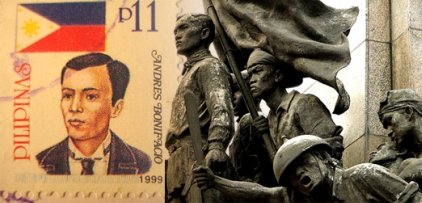November 30 is Andres Bonifacio Day in the Philippines
Bravery is an act of courage to fight for something you believe is right. A lot of people have given their lives as a way of fighting for pride and glory for the Philippine Islands, they are called Philippine heroes.
The Philippine heroes are the people that have fought for freedom and independence. Many of the Philippine heroes were revolutionaries in the fight for independence against Spain. One of them was Andres Bonifacio.
Andres Bonifacio was a Filipino revolutionary leader and patriot, known as the "Father of the Philippine Revolution." He was one of the founders and organizers of the Kataastaasan Kagalang-galang na Katipunan ng mga Anak ng Bayan or Katipunan.
Self-Education
Despite Bonifacio's limited salary while working in different companies, he still devoted some of his money to acquiring books to educate himself. Bonifacio managed to educate himself by assiduously reading whatever books he could obtain.
Andres Bonifacio was married twice but his first marriage did not last long as his wife, Monica, died of leprosy. After her death, he met Gregoria de Jesus of Caloocan and immediately fell in love with her. Later, the couple were also married under Katipunan rites.
The Katipunan
After the dissolution of the Liga and the arrest and exile of Rizal, a secret meeting was held at Deodato Arellano's house located at 72 Azcarraga Street on July 7, 1892. The meeting was attended by Bonifacio, Valentin Diaz, Teodoro Plata, Jose Dizon, and others. They formed the Kataastaasan Kagalang-galang na Katipunan ng mga Anak ng Bayan or Katipunan as a reaction to what they saw as the inherent weaknesses of the Liga and the reform movement and the necessity of ending Spanish rule in the Philippines.
Since most of its founding members were freemasons, the Katipunan employed the principles of masonry in its organization. Katipuneros used codes, hand signals, symbols, and secret initiation rites and ceremonies in accepting new members.

Andres Bonifacio (November 30, 1863 – May 10, 1897)
Katipunan membership grew with the passing of months. Andres Bonifacio became the central force in uniting and organizing the society, although he was not its first leader. It was only when the first set of leaders failed to live up to their responsibilities that Bonifacio established his leadership of the Katipunan and was eventually elected supremo.
Outbreak of the Revolution
Prior to the outbreak of the revolution in 1896, it was estimated that the membership of the Katipunan was between 30,000 to 40,000 Katipuneros. With such numbers, it was only a matter of time before its existence became known to Spanish authorities in the Philippines.
The Katipunan was finally discovered in August 1896. Andres Bonifacio had no choice but to launch the revolution, although prematurely, as the Spaniards started to arrest Filipinos who were actual and suspected members of the Katipunan. Gathering the Katipuneros, Bonifacio and his men tore their cedulas as a symbol of their struggle against Spain. He then gave orders to the different chapters of the Katipunan in various parts of the Philippines to begin the revolution.
The revolution spread like wildfire throughout the country but the most successful military campaigns of the Katipunan were in Cavite, where Katipuneros managed to liberate town after town. Gradually, hostilities shifted from Manila to Cavite as the Spaniards tried to counter these military victories. Both sides started diverting their troops and supplies to the province.
Tejeros Convention
Although it enjoyed military success in Cavite, the Katipunan in the province was unfortunately divided into two factions, the Magdalo and the Magdiwang. The Magdalo - headed by Emilio Aguinaldo - became powerful because of its success in defending its territories against Spanish attacks. The Magdiwang - headed by Mariano Alvarez - was losing its influence because of numerous military defeats. Because of the conflict between the two factions, Bonifacio was invited to Cavite to mediate and settle the differences.
Bonifacio arrived at the friar estate house in Barrio Tejeros, San Francisco de Malabon, Cavite. Upon the arrival of the Magdiwang and Magdalo factions, it was decided that the group should elect officials of a revolutionary government. Although he was the supremo of the Katipunan, Bonifacio submitted to the decision of the group regarding the formation of a new government. However, he reiterated to all participants in the convention that the result of the process should be respected by everyone.
Execution of Andres Bonifacio
On the morning of May 10, 1897, a sealed order was received by Maj. Lazaro Makapagal from General Noriel. The latter further ordered Makapagal to take four soldiers and escort the Bonifacio brothers to Mount Buntis. Noriel insisted that only upon arrival at said location would Makapagal open the sealed orders and follow the instructions. Makapagal, four soldiers, and the Bonifacio brothers marched along a trail leading to Mount Buntis. At the foot of the mountain, Andres Bonifacio asked Makapagal to open the sealed order. After reading the content, the Bonifacio brothers were shot and buried in a shallow grave marked only by a few twigs and leaves.


